#folk headwear
Photo

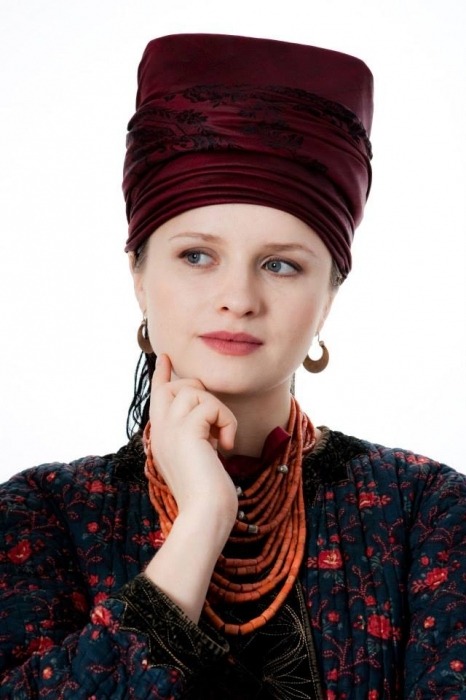
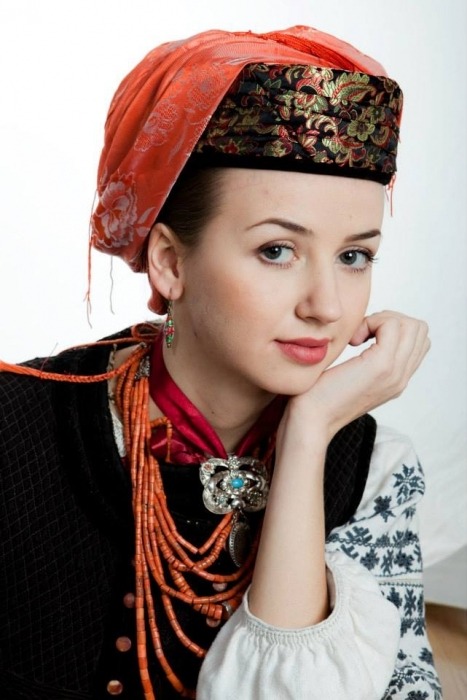
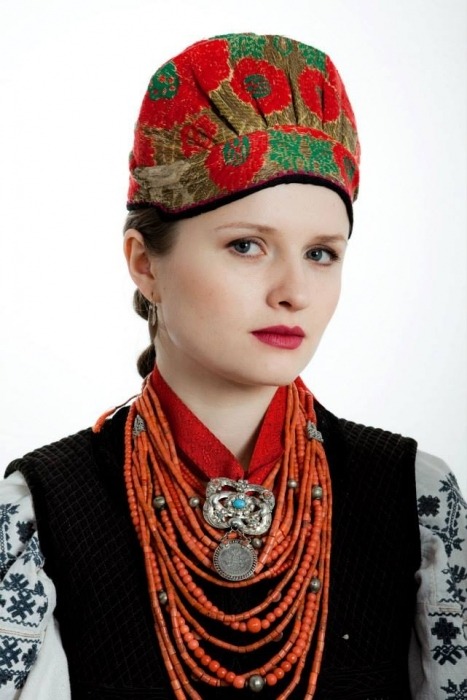



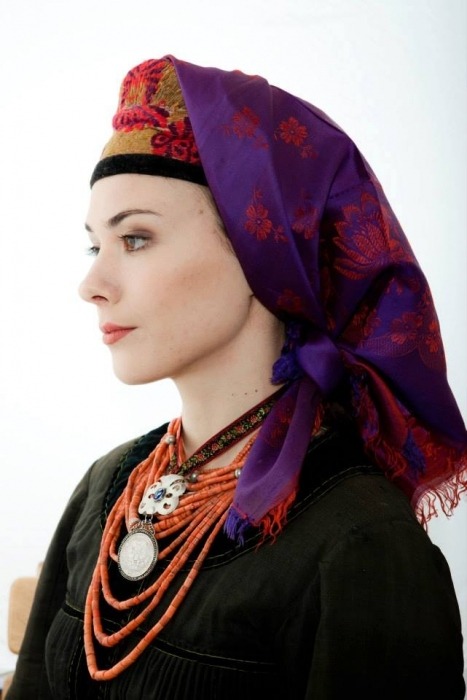
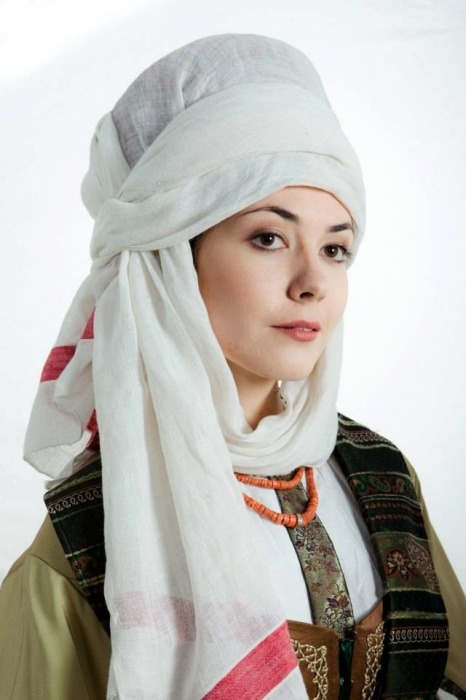
Традиційні головні убори заміжніх жінок з різних частин України у ХІХ-на поч. ХХ століть
Folk headwear of married women from different parts of Ukraine in XIX- beg. XX centuries
Source : Українські народні головні убори / Ukrainian folk headwear / Ukrayinsʹki narodni holovni ubory book by Halyna Stelmashchyk, 2019
#culture#world culture#folk culture#ukraine#folk clothing#folk headwear#headwear#folk wear#folk costume#traditional dress#ethnology#ethnography#anthropology#history of fashion#eastern europe#slavic#український tumblr#український тамблер
757 notes
·
View notes
Text


Traditional headwear from Prizren (south Serbia)
#serbia#srbija#personal#photography#photo#traditional clothing#narodna nošnja#prizren#tradition#balkan#narodna nosnja#folklore#folk#kosovo i metohija#b&w#headwear#jewelry
215 notes
·
View notes
Photo


Free Folk - Off White Fall 2023
#free folk#wildlings#Beyond The Wall#off white#menswear#knit#headwear#yellow#black#A Song of Ice and Fire#Game of Thrones
12 notes
·
View notes
Text
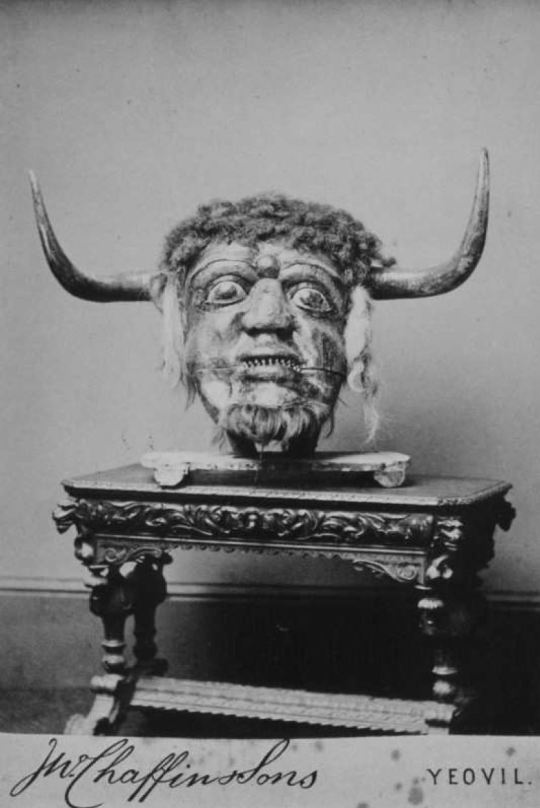

The Dorset Ooser from Melbury Osmond, Dorset, UK. Photographed in Yeovil, Somerset, c. 1883-1891.
A bit of odd photographic history from the town where I was born. Although the scale is difficult to discern from the photo, the Ooser was a largish headress that sat on the wearer's shoulders. The eyes were completely opaque and it's possible that the wearer could see through the 'mouth', which was hinged so that it could open and close. It's actual purpose is unknown, and thus lots of quite silly/colourful (take your pick) ideas have been dreamt up to explain it. The owners tried to sell it, hence the photo, but it seems to have been lost - to decay or being sold by a third party - sometime in the early 1900s. It was made from wood, wool/hair and horn.
#somerset#dorset#yeovil#melbury osmond#UK#england#history#weird history#folklore#local history#headwear#horns#photograpy#vintage photography#ooser#folk horror
4 notes
·
View notes
Text
writing nonfiction takes so much time and effort but especially so when you also have adhd
#I'm sure other people could do this more quickly and efficiently#but alas I'm not other people and actually have the attention span of a goldfish#it's fine I'll get there eventually MAYBE#my theory is that if I just keep chipping away and writing bits and pieces here and there every day#and then also have occassional proper writing sessions where I churn out 1000+ words#then MAYBE I can do this within the next month. maybe.#anyway I was writing about the 1920s and then got distracted by dutch books being stupid#and then started reading about womens rights and feminism etc and then remembered I had some photos I needed to add#and then I opened twitter (always a mistake no matter what)#I have also added the oldest photo of my town that I know of to my book (1866-1870)#and now I'm just going to quickly add some notes about headwear in folk dress and also womens votes#and then I'm calling it quits for today
1 note
·
View note
Text
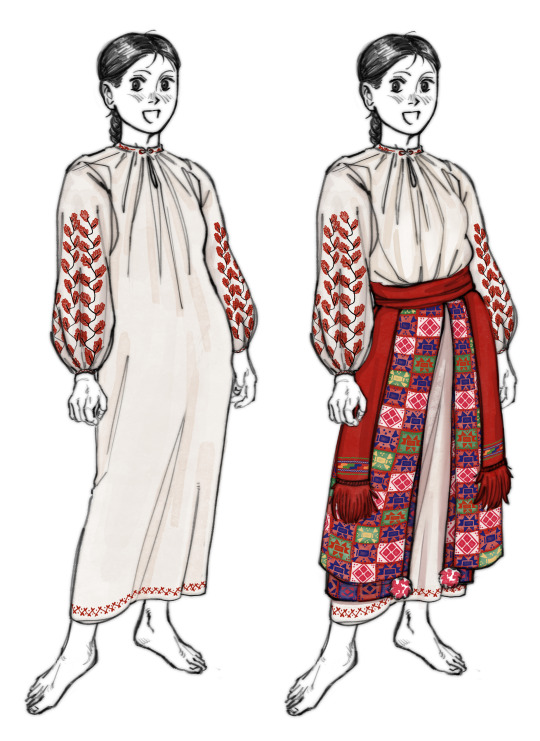


pretty devastating news just came in that if you want to be finished with your art project you have to work on it fairly consistently.
WIP on ukrainian folk costume + bonus headwear.

587 notes
·
View notes
Note
Hi my friend wanted to ask about Chinese Opera and the red pom poms on their hats and their significance. I asked my mom and she said they were for decoration so I just wanted clarification
Hi! Thanks for the question, and sorry for taking ages to reply!
The pom poms you see on 盔头/kuitou (Chinese opera headdresses) are called 绒球/rongqiu (lit. "velvet ball"). They are often red, but can also be other colors, and vary in size. Ronqiu are decorative and serve to distinguish the many different types of kuitou from one another. Each type of kuitou is distinct in the number, size, and color of rongqiu that it's decorated with (of course, not all kuitou have rongqiu).
Below - a few different types of Beijing opera kuitou decorated with rongqiu (x):

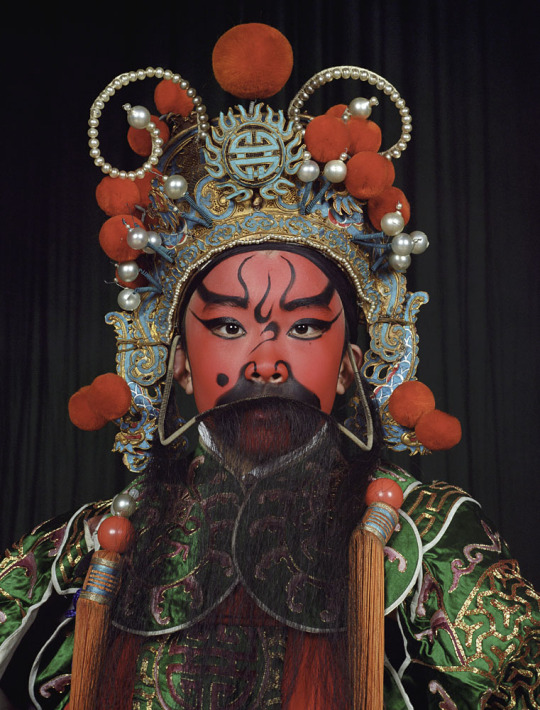
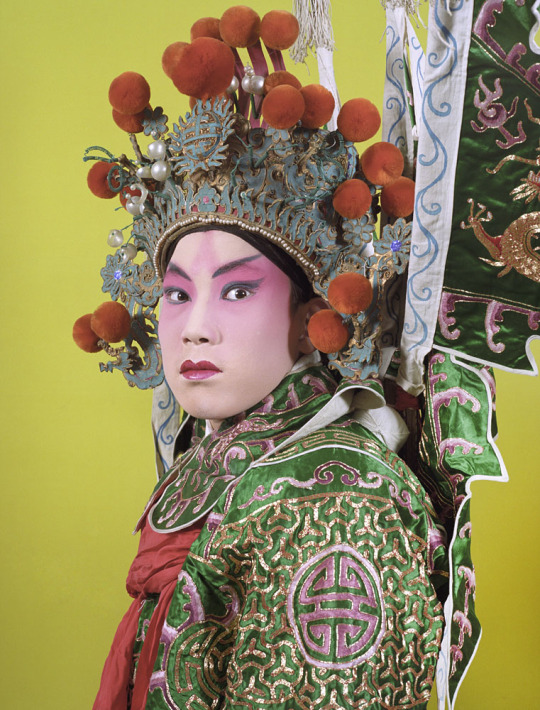
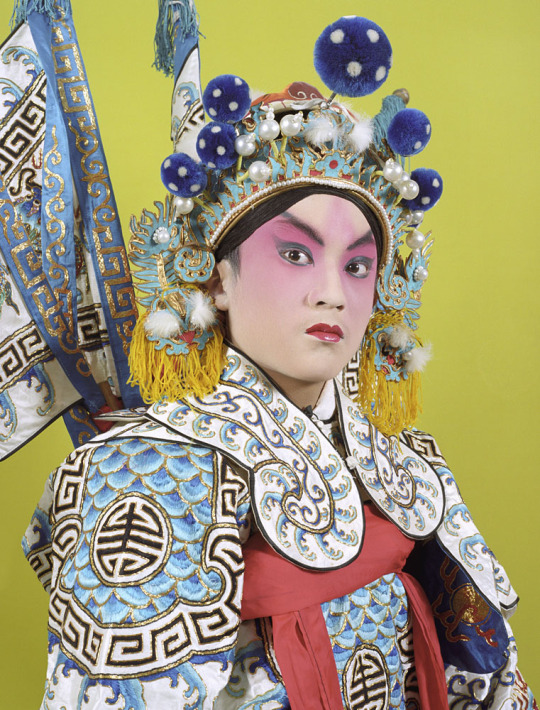

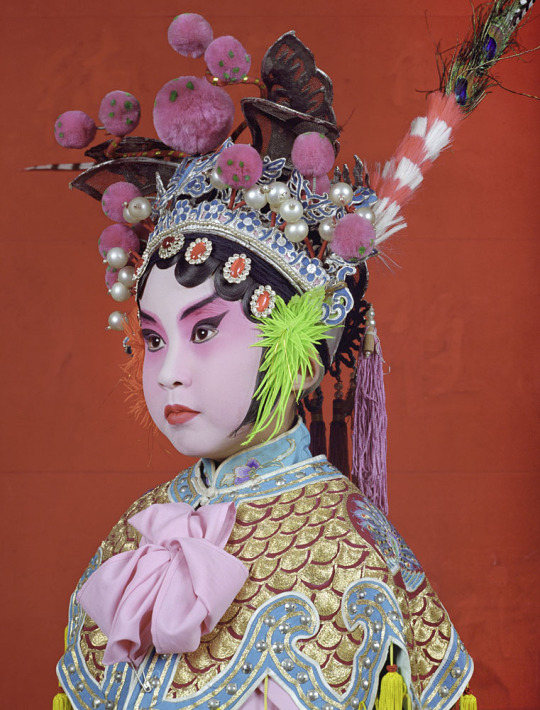
Rongqiu isn't used just for Chinese opera performances - it's a very common decorative item for Chinese headwear, especially for traditional/folk performances.
Below - examples of rongqiu use in folk custom/performance costumes, left to right: 1) 游神/youshen (wandering gods) procession in Fujian (x), 2) 英歌舞/yingge wu (yingge dance) performer in Guangdong (x), 3) & 4) 高跷/gaoqiao (stilt walking) performers in a 社火/shehuo parade in Gansu (x):

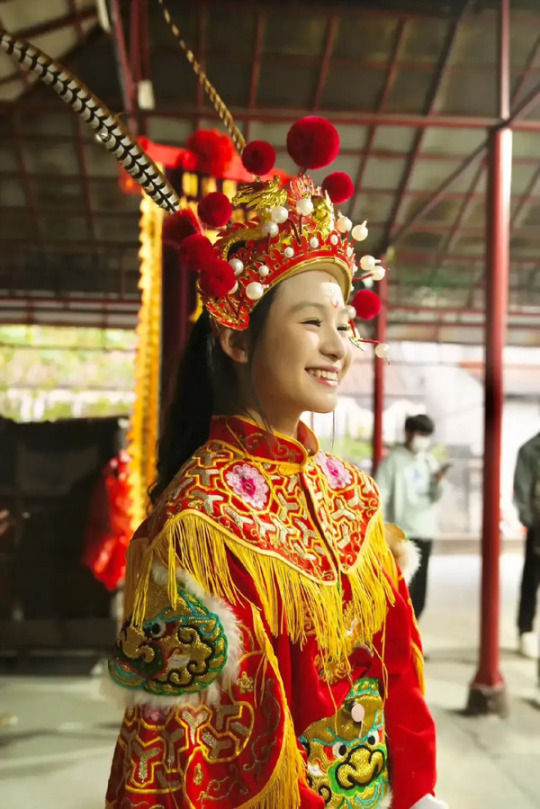

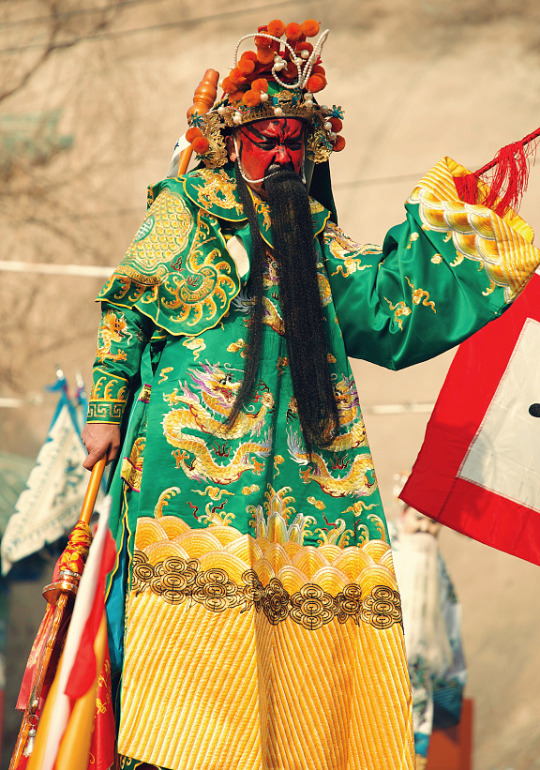
As a festive decoration, rongqiu was also widely used on bridal guan (crowns) from the Qing dynasty into the modern day.
Below - examples of rongqiu use in historical bridal guan: Left - a bride during the late Qing dynasty, circa 1890 (x); Right - a bride during the Republican era/minguo, in 1939 (x):
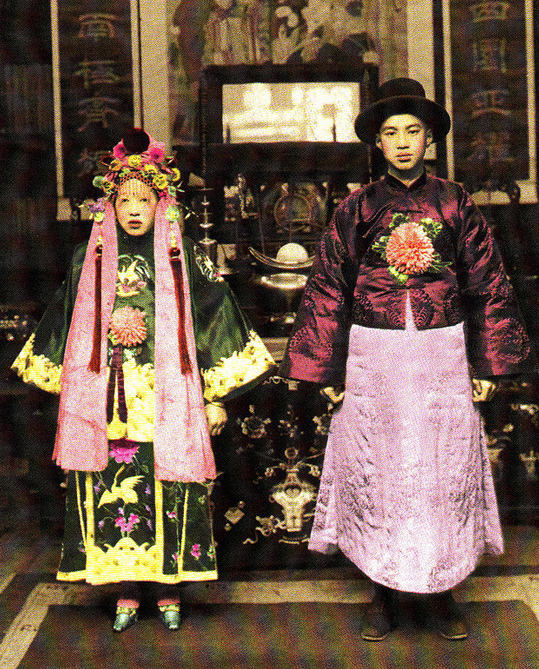
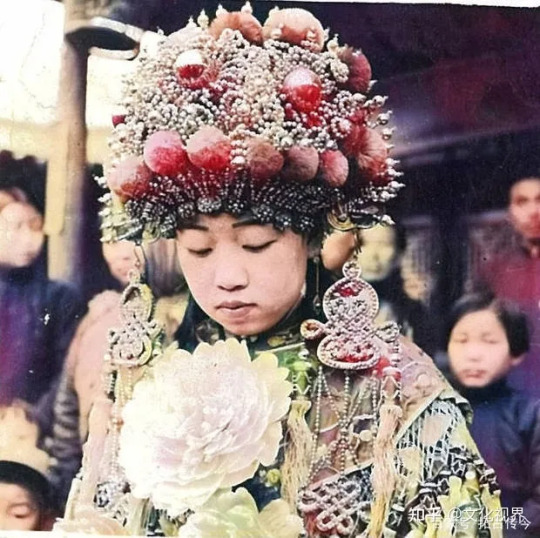
For some reason it's been extremely difficult to find sources on the origin of rongqiu that would shed more light on its significance, but based on historical paintings the use of rongqiu as a head ornament may have originated in the Qing dynasty. During the late Qing dynasty, it was fashionable among women to wear rongqiu on the sides of their hair, as can be seen in the paintings below (x):

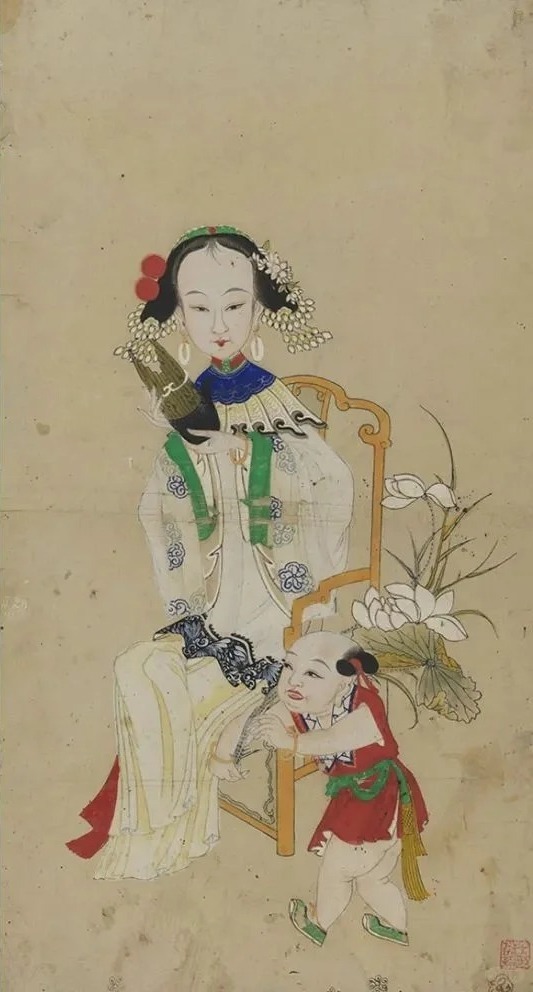
This particular style of rongqiu hair ornament was depicted in the 2012 historical cdrama 娘心计/Mother's Scheme:
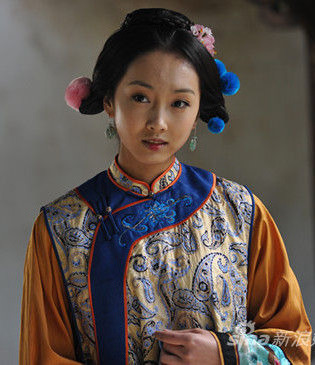
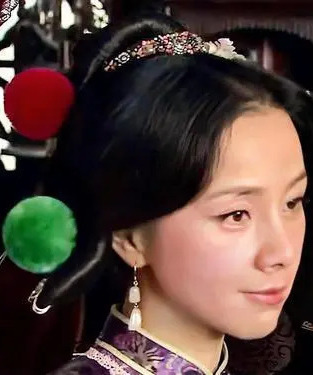
For more references, please see my rongqiu and kuitou tags.
If anyone has more information on the significance of rongqiu, please do share!
Hope this helps ^^
#rongqiu#pompoms#kuitou#chinese opera#opera costume#xifu#hanfu#history#reference#ask#reply#junpeicindystories#chinese fashion#chinese clothing#china
503 notes
·
View notes
Text
Fallout 3: Metro Car Armor
We understand that there are some misconceptions about how the Presidential Metro in Broken Steel works.
The way the scene works is quite interesting and we felt that we should explain how it's actually achieved, through a series of short videos!
When the player activates the train, an armor named “DLC03MetroCarArmor” is added to the player's inventory after the white fade-in.
The armor is identical to the train visually. It is not a hat, but a Right Hand glove. It will appear above the player's head in third person and block the player's view entirely if a weapon is unholstered in first person.
A script package named “DLC03MetroCameraPackage” is added to the player. This plays an animation called “DLC031stPersonMetroCam.kf,” which is what actually makes the camera shake, as well as makes the player/train move.
It is not intended to be viewed in third person and activating the train will always force the player into first person.
The armor is assigned to the player's Right Hand slot because hand models are visible in First Person, while headwear is not.
When combined with the armor and its associated script package, the armor adjusts its position, giving the result above. The white fade-in serves to hide the armor model repositioning itself, while also disabling (removing the model from the map) the original train that the player activated.
The armor and the animation are designed and also rely on the player being in first person. If viewed in third person, the player and the train are turned sideways and looks incorrect.

If you check the player's Right Hand in third person while the armor is equipped, their right hand will indeed become the train itself and thus, appear invisible.

So, there you have it folks! We hope this explanation was in-depth and informative! It was really fun to look into and discover how the scene truly works.
We did have multiple videos recorded for this, but Tumblr only accepts 1 uploaded video at a time. :(
We've made a page for the armor as well, which you can read here:
https://fallout.wiki/wiki/DLC03MetroCarArmor
#fallout wiki#independent fallout wiki#fallout series#fallout#fallout 3#fo3#fallout development#fallout technical#fallout 3 development#fallout wiki facts#fallout facts
264 notes
·
View notes
Text

Happy karlnapity anniversary folks
Explaining their headwear
807 notes
·
View notes
Note
As the fandom’s resident fashion historian, do you have any thoughts about wedding dresses/apparel in Planetos? Personally, I weddings are a great place to showcase the differences between the regions especially with traditions, superstitions, economy, and skills. For example, IRL there is a superstition, if a bride makes her dress, each stitch a bride makes is the equivalent to the tears she will shed during the marriage but I can’t see that translating to Westeros where the small folk or even every member of house Frey or house Reed aren’t getting a custom dress. Maybe it’s traditional to wear colorful dresses in Dorne and heavy jewelry made by talented blacksmiths in Westerlands and trading cities use dresses with pearls (because in Meereen pearls=fertility) and myrrish lace to flaunt wealth but the North cause practically and reusability over fashion and maybe they pass down dresses, the Reach probably produces cotton so I imagine they would have more stylish and intricate designs, Qohor might have headwear with religious figures hanging from the fringe... I’ve thought about it a bit but I’d love to know your thoughts! 💚💛🖤💚💛
This will also include the other wedding asks I got and will probably be a two parter since there’s a lot to cover!
Wedding fashions part 1!

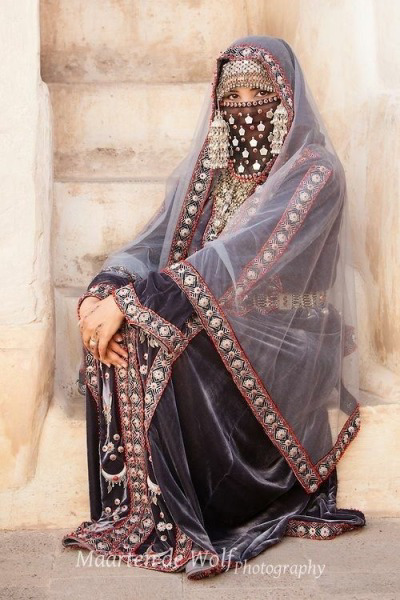
I’ve mentioned it before, but I like the idea of a Dornish bride “wearing” her dowry. Usually this consists of a veil made out of coins, or stitched into her gown, or placed into her headpiece. The fabric of the gown itself is also the finest the family can afford, and is expected to be sold if necessary (though noble families don’t usually do that). This practice isn’t only a tradition to show the groom’s family that he is not being swindled out of the agreed upon bride price, but is also a way for the family of the bride to show off their wealth. If a girl is especially wealthy, she may not even be able to wear the entire dowry, so her maids, ladies in waiting, animals, and every other thing she is bringing with her is decorated in wealth as well and presented to the groom
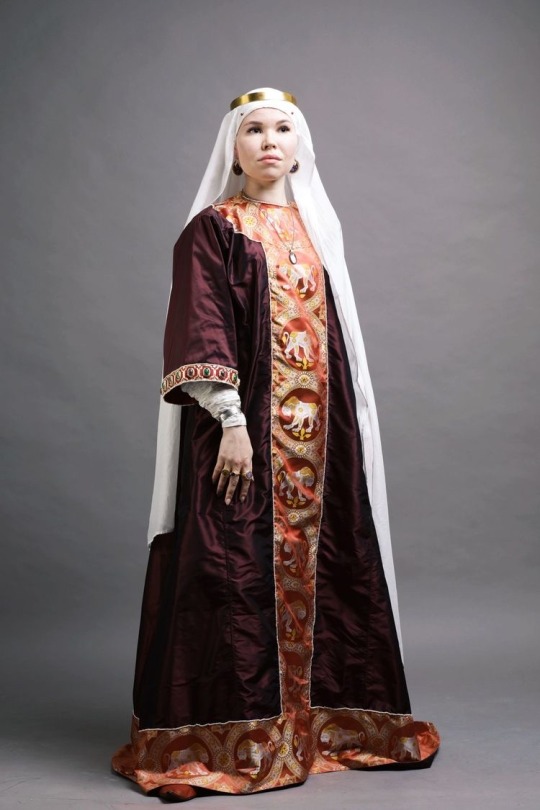
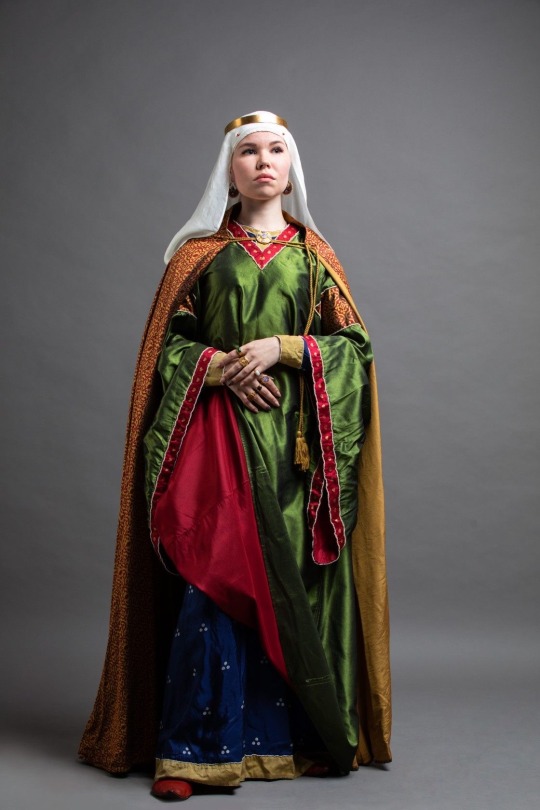
Stormlands women tend to be both proud and practical, so their dresses are made from the best materials they can afford, but practically cut and layered for the constant rainy weather. They’re also sacklike and large with very few adjustments so that the fabric can be repurposed later on. Most new gowns look like this anyway for the same reason, and wedding gowns are usually new. A woman’s dress will usually be in her family colors, and be patterned with their symbols as well, or maybe quartered with the grooms symbols and colors. If it’s not repurposed for other things, a gown might be reworn many times for social events, and even refashioned into a more stylish silhouette.
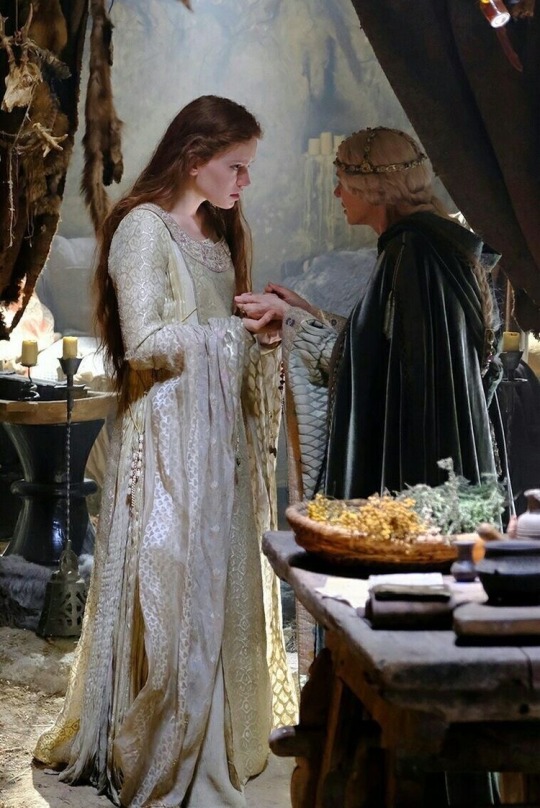
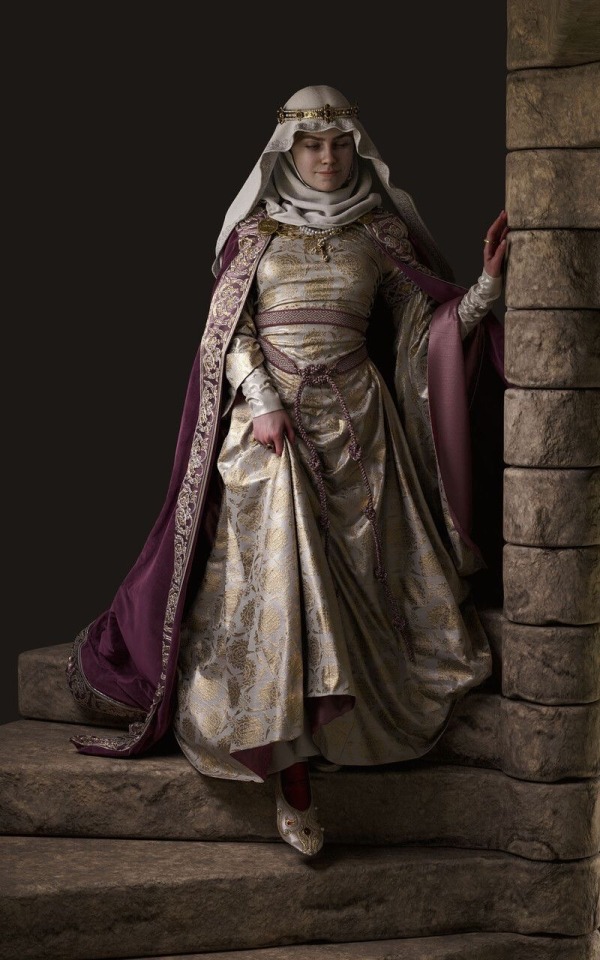
In the Riverlands, there’s no one type of wedding gown, as it’s so large and many of the brides will just wear one of their nicer gowns they already own, but the typical long flowing sleeves and loose overdress are common. Flower, vine, leaf, and other nature motifs are incredibly popular due to their connection to the fertility of the riverlands. So many girls will take a dress with a pattern, or embroider flowers onto it, or maybe pin real flowers onto their gowns, if they cannot afford to embroider or have a patterned gown. There’s a superstition that a bride with not enough flowers will not have any children, only have sickly/weak children. So the small folk especially incorporate as many flowers they can into their weddings


The Reach women’s favorite wedding tradition is seeing who can have the most expensive dress of the season. They’re even more ostentatious than their regular fashion, if that’s even possible. The puffed and slashed sleeves are made from the finest tulle and softest silk. Bodices trimmed in Myrish lace, patterned skirts that took months to make. Gold jewelry and hairpieces imported from the westerlands. Heavy wedding cloaks that are more pearls and thick embroidery than actual fabric. The cost of the yards of fabric used to make the gown is enough to make a Pentoshi merchant swoon. Essentially reach wedding gowns are just upping the ante of their regular dresses.
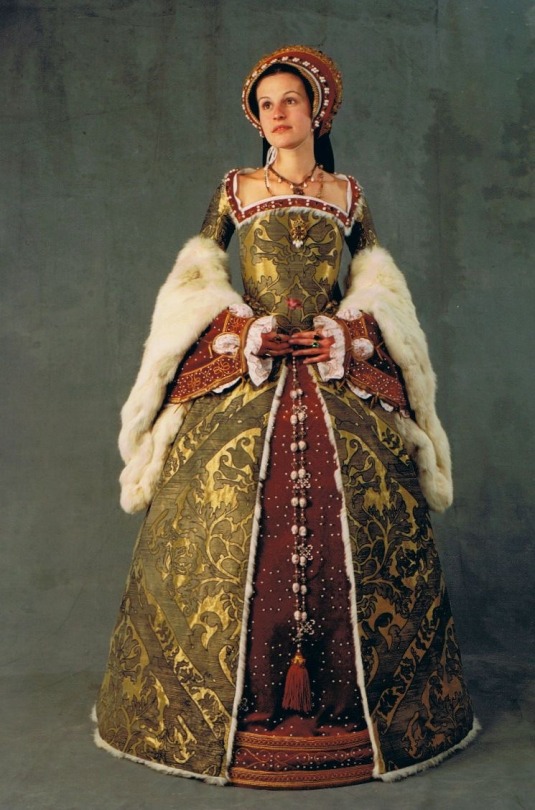
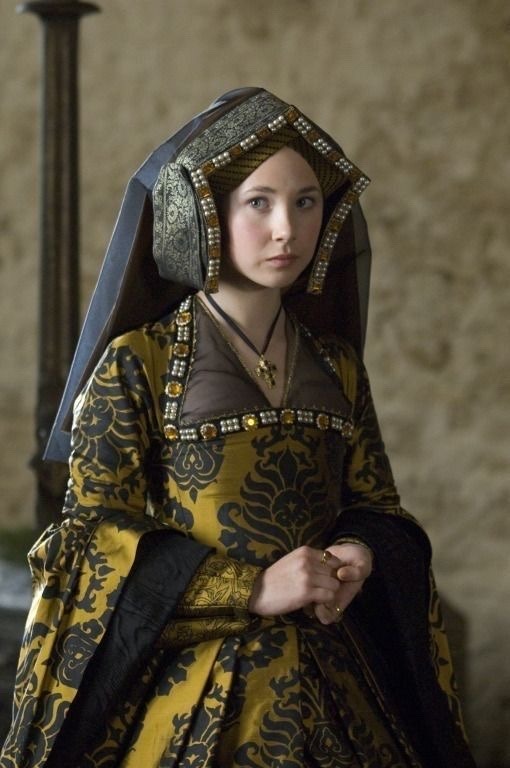
The wedding gowns of the westerlands are a bit less openly ostentatious than those of the reach, if only because someone doesn’t want to embarrass themselves in front of Tywin or Tywin-adjacent lords, who think to be too showy is a sign that you’re trying too hard. However the overdresses are still made of detailed brocade, necklines are decorated with pearls, and the lower sleeves are still big enough to drag. They still clearly rival the reach, but are also clearly having far less fun with their clothes. It might be a tradition for a woman to start wearing a type of hood on her wedding day, as a way to honor the mother and start promoting herself as lady of a noble house instead of an unwed girl
#asoiaf#asoiaf hair and clothing#you are going to take your Borgias inspired reach outfits again and you are going to like them
145 notes
·
View notes
Text
so making that post about meif'wa in headscarves and such made me think about religion in my rewrite and i remembered that i haven't spoken about religious headwear at all, so here is some stuff for Avra. I might post about other religion stuff for LR at some point too.
These are mostly aph-specific since no one religions the way she does lmao. Except for the coin-chain, that's a little something she starts doing that ends up being a cultural thing for Phoenix Drop because surprisingly the way rulers dress does persuade their people to dress similarly.

Coin Scarves are a Scaleswind thing, and quite an old-fashioned one. You're more likely to see a little old lady (or man, it isn't gender specific) in church wearing one than your average individual. Only hair that is longer than shoulder length is typically put beneath them (hence Avra's little microbangs being out) however in some parts of Scaleswind it is seen as more proper to cover the entire top of your hair regardless of length.
Different colour + metal combos refer to different divine, and multiple can apply to a singular Divine. People often wear them based off of the divine they follow most of all (Irene, for most), however those who only wear them for prayer will wear them according to the divine they're praying too. Pre-O'Khasis/Scaleswind war, royal-blue and gold was the most common combination as those were the colours most associated with Irene, however they're also associated with O'Khasis, so it changed to white and gold when the war began.
Avra gets hers during her little excursion to Scaleswind. Those who worship the Destroyer often thought of her quite highly for reasons, and she is quite recogniseable, so when she was just walking around a little old woman pressed a red and cold coinscarf into her hand and walked away. Red and Gold are colours associated with Shad only by his worshippers, however black and silver is more often used by the gaggle of elderly folk in Scaleswind that dare to worship him as they aren't ashamed of their religion. It is however seen as heresy, so any youth that continue the practice + worship Shad will often wear the red variant.
Avra honestly just thinks its cute (she is wearing it in my recent Shadmau/Shavra drawing :})

This is a coin veil, inspired by catholic veils because they're so goshdarn pretty. They're the predecessor of coin scarves and while coinscarves are made with opaque, typically thicker material, coin veils are made with lace or sheer fabric.
It is not practiced anymore, it kind of went out of fashion when the elaborate worship of the gods was replaced with the more humble and accessible worship of the divine. Coin scarves were kind of made so the church could try and make those that were fond of veils convert away from the gods, under the idea that 'they're basically the same thing anyway!!'.
Avra gets hers because it was a practice she partook in during her life as Irene, so she kind of was drawn to it. For Donna and Logan's wedding, she had an excuse to wear fancy stuff, so she asked Cadenza to help her make a coin veil. She doesn't remember what it's meant to actually represent, she just thinks they're pretty and comforting. Cadenza makes her a red one, using a bunch of lace she had already made, and it is very long. Avra only typically wears it for events or whenever she's stressed and needs to chill out.
Similarly to coinscarves, colour and metal indicate certain gods, but so does lace pattern and veil length. Worship of Judgement/Death (The destroyer/shad) was often indicated with long black veils with golden coins and the lace covering the face as well as the hair, with the lace usually having patterns of wilted flowers and animal skulls to represent the very decay they worshipped. Of course, this could only be afforded by the very rich, however the rich were often patrons of his temples in larger communities and would supply them with veils for the worshippers to wear. The addition of coins to veils was thought to have started with Judgement/Death worship, as it was believed that if someone was buried in their veil and brought back, you would be able to hear them by the chiming of the coins. Which was good because you didn't want an SK sneaking up on your ass, even back when Shad was thought of highly.
Worship of The Mother (Irene) was done through medium-length white-lace veils which were usually not adorned with coins (though were still called coinveils) but had beads instead, and were typically tied or pinned closed around the chest. The lace usually had floral patterns on it, though not always. Irene herself wore one, however due to lace being very hard to carve, most of her statues depict her wearing a hood instead.
I could get into the impacts of Avra wearing her red little coin veil but naaahhhh.
#aphmau#aphverse#rewrite#aphblr#minecraft diaries#mcd#ranthredo#Lycoris Radiata/Ranthredo#Avra of Phoenix Drop#religious lore
31 notes
·
View notes
Photo

La Cueillette des Pommes
This set is (hopefully, we’ll see) the first set of a series of 1870s and 1880s inspired clothing sets. It includes a blouse, bustle skirts in 3 lenghts, an accessory apron and some little cloth caps for all ages.
More pics and download below
As referenced in the title, this set was inspired by a Camille Pissarro painting : La Cueillette des pommes / Applepicking,1886.
————————————— Blouse ————————————

—————————————————————————————
This blouse is tight fitted and has a high collar as was fashionable during most of the 1870′s and 1880′s.
73 swatches : 22 solids, 10 floral, 5 plaid, 25 striped & 11 polka dot patterns
————————————— Skirts ————————————

—————————————————————————————
These skirts have a slight bustle shape which would best fit for the natural form era : roughly 1875 - 1883 ; (well actually, the size of the bustle is dependant on the size of the sim’s butt so do with that what you will). Though to be fair, juging from the paintings I went through, the fashion shift wasn’t as visible in work wear for rural folks and manual workers (the painting I took inspiration from is from 1886 after all) given they didn’t go all in with the bustles and skirt lenghts in these situations, so I guess in this context these skirts might work fine for the rest of the 1880′s as well.
I decide to make 3 versions with each a different lenght to have more teen options as well as worker friendly options (as stated above the lenght of manual workers skirts was usually a bit shorter). The short one end mid calf, the medium one is a bit above ankle lenght and the long is a bit below.
65 swatches : 22 solids, 23 with two stripes at the bottom & 20 with a pattern “trim” at the bottom
3 lenghts : S, M & L

(versions with patterns matching the blouse’s can be found in La Mousme set)
————————————— Apron ————————————

—————————————————————————————
Apparently I still don’t have enough aprons so here’s this one 😅
This apron is longer than the previous half aprons I made and warp around the skirt more because that was the style I saw all the women wearing while looking through paintings of markets, farm folks at work etc. I also made it in more colours : again in the paintings the aprons were mostly medium or dark blue, and also sometimes brown or black.
22 swatches (all solids)
for all ages
————————————— Caps ————————————

—————————————————————————————
I’m not quite sure what kind of headwear is the one pictured in the original painting but it reminded me of baby caps of the 19th century so I ended up making something kind of in between for adults, children and toddlers. I tried my best to make the cap work with as many CAS hairstyles as I could but I would strongly recommend using hat sliders (adult and kids) otherwise you’ll be in for very little hair options without major clipping.
24 swatches : 22 solids, 1 white lace & 1 black lace
for all ages
hat slider compatible
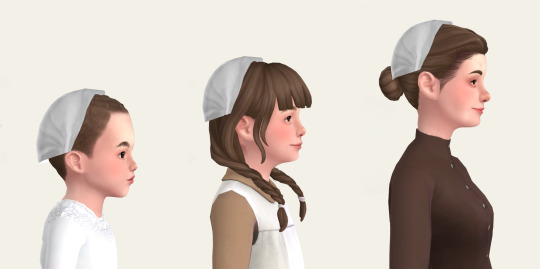
————————————————————————————
Download : dropbox — simfileshare
————————————————————————————
#my cc#1880#clothes#accessories#teen#grown up#hat#toddler#child#ts4cc#ts4 clothes#ts4 historical#sims 4 cc#sims 4 clothes#sims 4 historical#maxis match#decade challenge#1880s Impressionism Sets
514 notes
·
View notes
Note
On my knees begging for a response letter from Lenny per your most recent prompt
p.s. Wanted to let you know how appreciated and admired your work is—Guess Who’s Coming to Yom Kippur is an all time favorite
Thank you so much! ❤️❤️❤️ I've had so much fun writing these crazy lovebirds. Guess Who's Coming to Yom Kippur was my first go at writing for the Maisel fandom and it has been so touching hearing how many people it's resonated with. I've loved writing it every step of the way. I think I originally came up with the vague idea while watching season 3? After I caught up on season 4 I finally decided to take the dive. And here we are! Just goes to show it's never to late to write the fic. It's becoming a series because I fell in love with the story and the more I write, the more I discover yet to tell.
And now, by popular demand, let's here from Lenny...
Dear Midge,
No gout here out west as far as I'm aware. It's a big state, so there's probably some poor schmuck stuck with it out there but the Bruce family abode remains unscathed.
It's nice to hear from you. I dig the pink stationary. Is it lightly scented? Or am I imagining things? Quite possible. I've been thinking about you too.
California is okay. Still adjusting to the amount of sunshine and phony smiles, still can't find a decent deli, but Kitty is here and she's great. That's my daughter's name, by the way. I don't know if your delicate headwear would fit over my ego bloated cranium but I'm sure she would love to add to her dress up collection. We've been raiding my mother's limited stash in the meantime.
There's no one else who's turned my head. I'm starting to think no one else ever could. It's like my nose became a compass that fateful rainy night we shared the back of that cop car, with you as my true north.
Perhaps that's how we always seem to find each other.
As much as I'm sure the neighbors would love the show, the streaking is unnecessary. You've always had my attention. I've been captivated by you from the very start. Since you saw through my bullshit and asked me point blank if I loved it.
If you simply must be naked, I am powerless to stop you. All I ask is a chance at a private audience.
I've often considered the calculation of time zones well into the night as well, if I'm being honest, but well… maybe we can revisit that another time.
I wouldn't mind seeing you behind Gordon's desk, but I'd much rather you get paid for it. Or have your own desk, better yet.
I'm proud of you for keeping at it. It's not an easy game, this comedy shit. And television is a whole other ball field. All the censors and meddling producers. Audiences across America to play to instead of the folks right in front of you. But I still believe you can do anything you set your mind to. Just keep looking for that spotlight. You'll know it when you see it.
As for the thank yous of your letter, it was always my pleasure. Lending a hand, an ear, a shoulder, the coat off your back… It's what you do for the ones you love.
You know…I've always been partial to blue but between that negligee and the shades of your eyes it's cemented its place as my favorite color. And the night at the Mayflower… I want you to know you were always worth the wait.
If you do ever find yourself with a ticket to the west coast, perhaps we could find ourselves in another someday.
I've still got the legal stuff, and now the kid stuff, and some of my other stuff…but I'm trying to figure it out. Be someone worthy of worshiping your show corset. Or the dentist corset. Do you have a corset reserved for air travel? I'd be interested to find out, if you'll let me.
I can't make you any promises. God knows you deserve so much more than I can offer. But a part of me holds out hope all the same, selfish as it may be.
Give Peluso my regards.
Yours. Always.
Lenny
25 notes
·
View notes
Text
Little Red Riding Hood: The dark roots
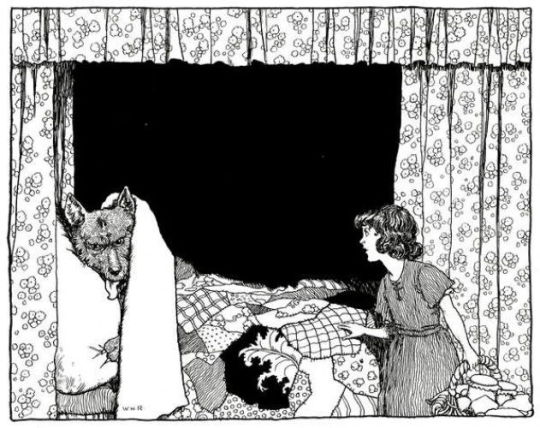
My professional edition of Perrault’s fairytales (by Tony Gheeraert) includes a part discussing the oral variations of the tale, and the folkloric roots of this emblemetic “AT 333″ story. Now, Tony Gheeraert uses the work of Paul Delarue in his “Le conte populaire français” - which is a title hard to describe due to French terminology for tales being different from English ones, so I would hesitate between “The French oral fairytales” and “French folktales”. Anyway it is a study of the fairytales of France in their oral, folkloric state, and he noted that, due to the immense popularity and large spread of Perrault’s version it is hard for folklorists to fnd back the “original” folktales Perrault might have taken inspiration from - most variants collected are just influenced by or copies of Perrault’s tales.
HOWEVER Paul Delarue believes he found twelve variants of the story that were “untouched” by Perrault’s tale, or that stayed faithful to the roots of the story pre-Perrault - and it is from these twelve versions that he tried to reconstruct what the fairytale might have looked like before Perrault. He also managed to identify the region where this fairytale seemingly originate: it is a geographical region that geso from the Loire river to the Tyrol, passing by norther Italy and the northern Alps. It is thanks to this “reconstruction” of the original tale that we know for example that Perrault invented the “red chaperon”, this red headwear that would become the “riding hood” of the English version. But we also know a lot about what Perrault “cut off” or did not include...
For example, the “original” tale had several episodes that were much more sexual or repulsive - and that, if Perrault knew about, cut off for decency. Two episodes in particular are prominent: the “stripping” sequence and the “meal” sequence. In the first scene, before going to bed, the girl removes her clothes one by one, asking the wolf (or the werewolf in some variations) where she should leave them. Only for the wolf to answer “Throw them in the fire, you won’t need them anymore.” This discussion is repeated for each item of clothing - the apron, the dress, the corset, the shoes... The second scene shows the wolf not devouring the grandmother whole, but puts a bit of her flesh on a plate, and her blood in a bottle. When the little girl arrives at the house, the wolf-grandma encourages her daughter to “Eat some meat” from the plate in the cupboard (well, “la huche”, which is a different item where you store food, but you get the idea) and “Drink some wine” from the bottle. The little girl accepts her grandmother’s orders - only for a cat to suddenly insult her for “eating the flesh and drinking the blood of your grandmother!” (Usually the insult goes something like “Stink, whore who eats the flesh .. !” These two episodes are notably present in “the original Little Red Riding Hood fairytale” that was presented by the Sandman comics, by Neil Gaiman - you can find my quick post about it here.
It is also pointed out that Perrault did not invent the dark and abrupt ending of the girl being devoured, and that’s it - it is one of the two typical endings of oral variations and folk-variants of the tale. The other is one where the girl survives and escapes the wolf - but it is not the Brothers Grimm’s ending. This ending, where a woodsman saves the girl and her grandmother, seems to have been an invention of the woman that told the Brothers Grimm the tale, and lifted out of a popular theater play of the time - but more about that when I’ll look into the Brothers Grimm version. The “good ending” of the French folk-variants actually are about the girl escaping the house by pretending that she needs to go to the toilet, so to speak - she claims she either has to pee or defecate, and she cannot do it in the bed, so the wolf allows her to go outside to relieve herself, but she takes this opportunity to run through the woods and return home.
Perrault also removed the typical motif of the “path of pins and path of needles”. I have talked about this prominent element of oral variations of Little Red Riding Hood here already. If you are not familiar with this: in oral variations of the story, when the wolf and the girl split path by the wolf’s injonction, the wolf asks the girl “Will you take the path of pins or the path of needles?”, and the girl answers one or another. The theory brought forward here to interpret this element is that the pins and needle refers to do different activites of women: the needles represent the work of weaving, while the pins represent ornaments and dressing up. So, the choice between those two paths could mean a “work VS play” division, or a “learning a trade VS pretty yourself up” (with possible vanity connotations?). But most importantly, the divide seems to be interpreted as choosing between the activites of a young child, and the actions of an adult woman. Though which is which stays unclear and is up for debate...

To complement that, I will bring forward the content of another book, which covers fairytale villains and how they evolve as a whole throughout children literature - and it has a little annex at the end covering the different versions of Little Red Riding Hood.
It highlighest the same differences talked about above, with a few additional elements. For example, there is here a different interpretation of the “path of pins and path of needles” : for Yvonne Verdier, these elements actually play in the sexual understones of the story. The pin is a symbol of “attachment”, that unites two things together, and thus it is a symbol of love (lovers notably exchanged pins as a gift) ; while the needle, with its hole, is a sexual symbol. And thus, this choice seems to be tied to puberty, and to the girl either having to go through the romantic road or the sexual one. Though Yvonne Verdier still highlights that this symbolism is not universal, since in several variations the name of the paths chance: “path of small stones”, “path of thorns”, “path of flowers”, “path of strawberries”... The “cannibal meal” is also evoked here, but with yet a different variation - where the wolf doesn’t encourage the girl to just eat and drink, but actually asks the girl to cook the raw meat for the supper. Finally, the escape by invoking the need to go, let’s say answer nature’s call, is also mentioned here - but with an additional element. Usually in those versions, the wolf agrees to let the girl go outside, but not before tying to herankle a thread or a piece of wool, to keep her attached to the house. However outside she ties the thread to a tree while she escapes. And here, the book precises, two more variations occur: in one the wolf only realizes too late that his prey escaped, when she is already back one. In the other the wolf notices the trick and hunts the girl down throughout the forest - the girl encounters washerwomen doing their laundry by a river and she asks for their help. They use their laundry to build a bridge above the river fo the girl to cross, but when the wolf tries to do so too, they remove the cloth, letting the beast drown in the river.
What is even more interesting is that the author of this book (Eva Barcelo-Hermant) puts in her book the oldest written version of “Little Red Riding Hood” she could find, which is a text of 1020, published in Latin by Egbert de Liège. It is a tale called “De Puella a Lupellis Servata” (the little girl spared by the wolf-cubs), which is found in a bigger book called “Fecunda ratis”. And the story basically goes as such: The narrator of the story says it is a tale known by peasants, and while it seems extraordinary, one must believe in it. On the day of the Pentecost, a man offered to a little girl a dress of red wool for her baptism - it was the same man that had held her during said baptism (aka, it was her godfather). When she was five, one morning at sunrise, the little girl wandered into the woods, unconscious of the danger. Suddenly a wolf attacked her and dragged her in the depths of the forest, up to his lair, where it left her for his cubs to eat. The cubs attacked her, but couldn’t harm her, so they rather caressed her sweetly. The child said “Little mice, do not tear my dress! It is my godfather that gave it to me for my baptism!”. The conclusion is: “God, who is their creator, appeases the spirit of wild beasts.”
As you can see, a strongly religious tale which a quite distant relationship to Little Red Riding Hood... But what is quite fascinating here is the fact that the religious nature of this old story can also be found in modern days Little Red Riding Hood. There is a LOT of religious context and subtext around this tale - in fact, I read some times ago an entire historico-literary article that dissected the religious roots, religious interpretations and religious re-writings of Little Red Riding Hood, and which highlighted how red dresses and red hoods were tied for a very long time to baptism outfits for children. Maybe I’ll dig back this article to post about it on this blog, one day.

#little red riding hood#the big bad wolf#french fairytales#perrault fairytales#folkloric fairytales#literary vs folkloric#french folktales#dark fairytales#horror fairytales#red riding hood
38 notes
·
View notes
Note
Do you have any reference material on Russian traditional clothing? For art and character design reasons; thank you in advance! <3
That's a whole thing, traditional clothing, isn't it. You can start with Wikipedia and go from there. It lists all typical items of clothing and headwear. Every region and sub-region of Russia had a different style, different in colors, design, stitch pattern, jewelry etc. Peasants, merchants, land owners, military and church people had different clothing.
Other sources I can think of:
This 1969 postcard illustrated by Natalia Vinogradova. It shows clothing of different regions of Russia (mostly peasant).
This book - "Русский народный костюм как художественно-конструкторский источник творчества" Фёдор Пармон (Russian Folk Costume by Fyodor Parmon) (excerpt)
Russian traditional costume from the collection of the Hermitage museum (here)
And finally, my old posts.
67 notes
·
View notes
Note
Since you have the know power, might you be able to help me with an issue. I freaking hate that my sims no longer get naked or take showers naked! It is always some random ass piece of clothing or headwear. Is there a way to fix that?
Oh there is!! That used to happen all the time when I would give a toddler a bath, they had on some random outfit. Then one day after cleaning my mods it stopped happening (also I found one of the outfits and tossed it).
Its a S4S fix as well, but folks please chime in if there's a different way?

I believe its as simple as running the Disallow CC for shower batch fix. I hope it works for you! And if not, I hope someone can comment on a different way! Try this out though and make sure you have the latest version of S4S.
26 notes
·
View notes